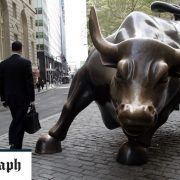There’s plenty for investors to keep an eye on in the final quarter of 2020, with the US election and Brexit grabbing the headlines. Before we get to either of those, however, there’s the small matter of the third-quarter earnings season, which kicks off this week. Earnings are the principal driver of share prices, and never more so than in this quarter as we pivot from 2020’s slump in profits to the expected bounceback in 2021.
Looking on the bright side, it won’t be hard for the July to September quarter to come in better than the second three months of the year, when earnings in the US fell by 32pc on average and by a whopping 51pc in Europe. Bad as these falls were, they were actually a bit better than expected in light of the near-shutdown of the economies on either side of the Atlantic. The forecast drops of 21pc in the US and 38pc over here in the third quarter are likely to be closer to analysts’ predictions and so less likely to give markets a lift.
Notwithstanding the September wobble, the V-shaped bounce in stock markets since March has seen investors looking beyond the ongoing slump in profits to next year’s forecast recovery. US earnings are expected to show a smaller 13pc drop in the last three months of 2020, according to Credit Suisse, before rising 13pc in the first quarter of 2021, and by 26pc for the whole of next year. In Europe, the reversal will be even more dramatic, down another 23pc in the last three months of 2020 before a 33pc rally at the start of next year.
One of the big themes in this results season is likely to be continued divergence between the economy’s winners and losers. Energy continues to struggle in a low-oil-price environment, financials are struggling to turn a decent profit as interest rates remain on the floor, and companies offering discretionary items – cars, clothes and durable consumer goods – face persistently weak demand as the threat of unemployment dampens consumer sentiment.
The technology sector, on the other hand, is forgiven for thinking crisis, what crisis? Profits in the software and services and semiconductors sub-sectors will be higher than a year ago. Same story in pharmaceuticals.
Insurance also looks unfazed by the pandemic. Broadly speaking, defensive sectors are outperforming economically sensitive areas and large companies are doing better than small.
In previous market recoveries, rising share prices were a reflection of an improving economy and were accompanied by rising interest rates and bond yields. This time around, the market rally has come more quickly than it usually does and has been fuelled as much by massive monetary and fiscal stimulus as by a better outlook. This has had important implications in the stock market.
Traditionally, the bounce off the bottom in a market cycle is fuelled by the lowest-quality, cheapest stocks. It’s a rally that reflects investors’ relief that these most marginal businesses are actually going to pull through and survive. The winners in 2009, as we emerged battered and bruised from the financial crisis, were companies with the lowest returns on their assets, the value not the growth stocks.
That’s not been the case this year. It’s been the high-quality, growth shares which did better on the way down and which have also outperformed on the way up.
Investing has been a one-decision game so far this year. To capture the best stock market returns, you simply had to chase the fastest-growing companies, those deriving the best returns from their invested capital, those with the fattest profit margins, and those with the lowest debts on their balance sheets. On all of those measures the correlation with returns has been exact; higher quality has delivered higher returns.
This divergence has added to the alphabet soup investors have used to describe the shape of the recovery.
First, we had the hope for a quick V-shaped bounceback. Then, we accepted that a shallower bathtub or U-shaped recovery was more likely. Now, people are talking about a K-shaped recovery in which the fortunes of the pandemic’s beneficiaries and victims diverge.
The limit on the extent to which this bifurcation of returns can continue will ultimately be set by valuations.
At some point, the valuations of the highest-quality, most popular shares will stretch to breaking point. But there is no sign that we are anywhere close to that point yet. Counter-intuitively, the best indicator of returns this year has not been a cheap valuation but an expensive one. The higher the price-earnings ratio, the better the share price performance.
Perhaps valuations only really matter at the extremes. Moderately high multiples of earnings, such as we have at the moment, may suggest investors should temper their enthusiasm but not to the extent that they miss out on the market’s continuing momentum.
Moreover, while the most important driver of returns in the short term is the change in a company’s valuation multiple, in the long run what matters is earnings growth. If you are in for the long haul, it makes sense to pay a bit more for quality. At some point, a genuine economic recovery will force interest rates and bond yields higher, and the long-term reliability of return offered by technology and other growth sectors will seem less important to investors. When that happens, we will start looking for value again. That, however, is for another earnings season, not this one.
Tom Stevenson is an investment director at Fidelity International. The views are his own. He tweets at @tomstevenson63


























Comments